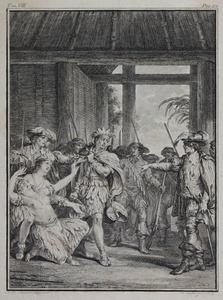| Method | Copper engraving |
| Artist | Pierre Duflos after Jean-Michel Moreau |
| Published | c. 1780 |
| Dimensions | Image 182 x 135 mm, Sheet 205 x 146 mm |
| Notes |
The seizure of the Inca ruler Atahualpa by Francisco Pizarro and the the Spanish at the Battle of Cajamarca, from the Abbé Raynal's 'Histoire philosophique et politique des établissemens des Européens dans les deux Indes', a study of colonialism heavily influenced by the Enlightenment, banned in his native France in 1779. The Battle of Cajamarca (16th November 1532) was the first military action of the Spanish conquest of Peru. Pizarro and his men, greatly outnumbered by the armies of the Inca ruler Atahualpa, had been lured into the heartland of the Inca Empire through promises of friendship. Realising that their success and personal safety relied only upon maintaining Inca belief in their semi-divinity, Pizarro planned a reckless and cold-blooded ambush in the Incan city of Cajamarca. Having invited the Emperor to meet with him without an armed escort, Pizarro and his men opened fire on the Emperor's unarmed retinue in the great plaza of the city. The Spanish guns, cannons, and cavalry terrified the Inca, and first hand accounts, both Incan and Spanish, describe a massacre of up to 2000 of Atahualpa's attendants and councillors. The Emperor himself, on a palanquin at the centre of the retinue, was captured and used as leverage to control the vast Incan armies outside the city walls. The unfortunate Atahualpa, having outlived his usefulness, was executed less than a year later. 'Tom. VIII Pag. 271' inscribed above image. Pierre Duflos (1742-1816) was a French artist and engraver, the son of Nicholas-Simon Duflos and nephew of Claude-Augustin Duflos, also engravers. He is best known for his engravings of New World costumes and topography, which appeared in numerous French travel books and accounts of voyages. Jean-Michel Moreau (26th March 1741 - 30th November 1814) was a French draughtsman, artist, and engraver, particular known for his work as a reproductive engraver of Old Master and French baroque painters. He provided plates for Diderot's Encyclopedie, as well as for the works of Boucher, Gravelot, and Cochin. Despite the turbulent political times in which he lived, Moreau flourished under both Royal and Revolutionary patronage. Despite his sympathies with the Revolutionary cause, he continued his work under the Bourbon restoration, gaining a royal appointment under Louis XVIII. |
| Framing | unmounted |
| Price | £250.00 |
| Stock ID | 36504 |

